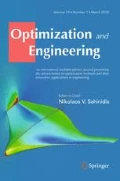Abstract
Although linear programming problems can be solved in polynomial time by the ellipsoid method and interior-point algorithms, there still remains a long-standing open problem of devising a strongly polynomial algorithm for linear programming (or of disproving the existence of such an algorithm). The present work is motivated by an attempt toward solving this problem.
Linear programming problems can be formulated in terms of a zonotope, a kind of greedy polyhedron, on which linear optimization is made easily. We propose a method, called the LP-Newton method, for linear programming that is based on the zonotope formulation and the minimum-norm-point algorithm of Philip Wolfe. The LP-Newton method is a finite algorithm even for real-number input data with exact arithmetic computations. We show some preliminary computational results to examine the behavior of the LP-Newton method.
Similar content being viewed by others
References
Betke U, Gritzmann P (1992) Projection algorithms for linear programming. Eur J Oper Res 60:287–295
Betke U, Henk M (1991) Linear programming by minimizing distances. ZOR—Methods Models Oper Res 35:299–307
Chvátal V (1983) Linear Programming. WH Freeman, New York
Fujishige S (2005a) Submodularity and polyhedra. In 4th Japanese–Hungarian symposium on discrete mathematics and its applications, Budapest, June 3–6, 2005
Fujishige S (2005b) Submodular functions and optimization, 2nd edn. Annals of discrete mathematics, vol 58. Elsevier, Amsterdam
Fujishige S, Zhan P (1990) A dual algorithm for finding the minimum-norm point in a polytope. J Oper Res Soc Japan 33:188–195
Fujishige S, Zhan P (1992) A dual algorithm for finding a nearest pair of points in two polytopes. J Oper Res Soc Jpn 35:353–365
Fujishige S, Sato H, Zhan P (1994) An algorithm for finding the minimum-norm point in the intersection of a polyhedron and a hyperplane. Jpn J Ind Appl Math 11:245–264
Fujishige S, Liu X, Zhang X (2000) An algorithm for solving the minimum-norm point problem over the intersection of a polytope and an affine set. J Optim Theory Appl 105:113–141
Fujishige S, Makino K, Takabatake T, Kashiwabara K (2004) Polybasic polyhedra: Structure of polyhedra with edge vectors of support size at most 2. Discrete Math 280:13–27
Fujishige S, Hayashi T, Isotani S (2006) The minimum-norm-point algorithm applied to submodular function minimization and linear programming. RIMS preprints series No 1571. Research Institute for Mathematical Sciences, Kyoto University, September 2006
Gill PE, Murray W, Wright MH (1981) Practical optimization. Academic Press, San Diego
Grünbaum B (2003) Convex polytopes, 2nd edn. Graduate texts in mathematics, vol 221. Springer, Berlin
Hwang FK, Rothblum UG (1996) Directional-quasi-convexity, asymmetric Schur convexity and optimality of consecutive partitions. Math Oper Res 21:540–554
Klee V, Minty GJ (1972) How good is the simplex method? In: Shisha O (ed) Inequalities III. Academic Press, San Diego, pp 159–175
Mangasarian OL (2004) A Newton method for linear programming. J Optim Theory Appl 121:1–18
McMullen P (1971) On zonotopes. Trans Am Math Soc 159:91–109
Nagano K (2007) A strongly polynomial algorithm for line search in submodular polyhedra. Discrete Optim 4:349–359
Onn S, Rothblum UG (2004) Convex combinatorial optimization. Discrete Comput Geom 32:549–566
Onn S, Rothblum UG (2007) The use of edge-directions and linear programming to enumerate vertices. J Comb Optim 14:153–164
Ortega JM, Rheinboldt WC (1970) Iterative solution of nonlinear equations in several variables. Academic Press, San Diego
Papadimitriou CH, Steiglitz K (1982) Combinatorial optimization—algorithms and complexity. Prentice-Hall, Englewood Cliffs
Polyak BT (2007) Newton’s method and its use in optimization. Eur J Oper Res 181:1086–1096
Renegar J (1988) A polynomial-time algorithm, based on Newton’s method, for linear programming. Math Program Ser A 40:59–93
Sekitani K, Yamamoto Y (1993) A recursive algorithm for finding the minimum norm point in a polytope and a pair of closest points in two polytopes. Math Program 61:233–249
Tardella F (1990) On the equivalence between some discrete and continuous optimization problems. Ann Oper Res 2:291–300
Todd MJ (2002) The many facets of linear programming. Math Program, Ser B 91:417–436
Tomizawa N (1983) Theory of hyperspace (XVI)—on the structures of hedrons. Papers of the Technical Group on Circuits and Systems, Institute of Electronics and Communications Engineers of Japan, CAS82-172 (in Japanese)
Wolfe P (1976) Finding the nearest point in a polytope. Math Program 11:128–149
Wright SJ (1990) Implementing proximal point methods for linear programming. J Optim Theory Appl 65:531–554
Ziegler GM (1995) Lectures on polytopes. Graduate texts in mathematics, vol 152. Springer, Berlin
Author information
Authors and Affiliations
Corresponding author
Additional information
Major part of this paper was presented as a plenary talk with the same title at ICOTA7 (December 12–15, 2007, Kobe, Japan) by the first author. The fourth author’s research was carried out while visiting RIMS in August 2007.
Rights and permissions
About this article
Cite this article
Fujishige, S., Hayashi, T., Yamashita, K. et al. Zonotopes and the LP-Newton method. Optim Eng 10, 193–205 (2009). https://doi.org/10.1007/s11081-008-9067-x
Received:
Accepted:
Published:
Issue Date:
DOI: https://doi.org/10.1007/s11081-008-9067-x




